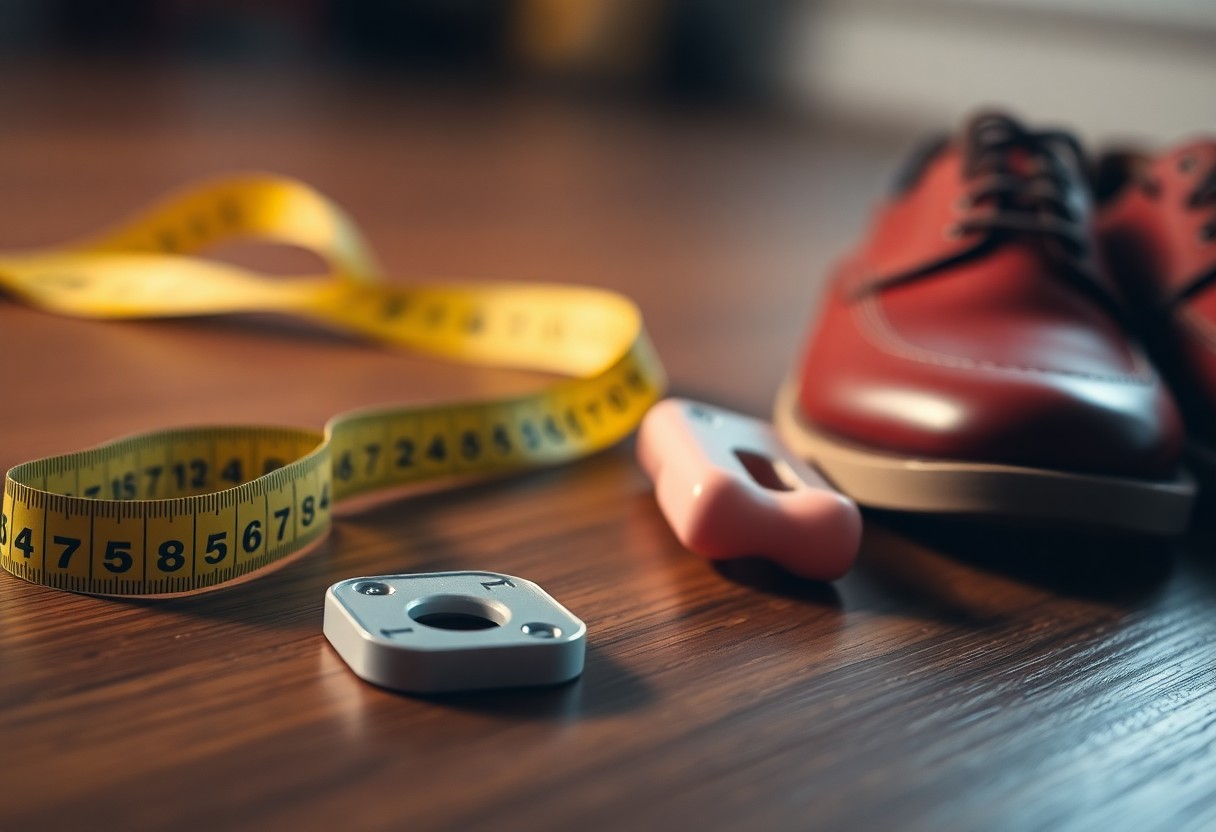
When you think you’ve tried everything for your foot problems, toe spacers emerge as a potential solution. If you’re wondering about their effectiveness, you’re not alone. These simple devices have gained significant attention for their ability to address common foot issues like bunions, hammertoes, and poor alignment. While some dismiss them as another wellness fad, research supports their benefits when used correctly. You’ll find that toe spacers can help improve your foot function, but their success depends on proper use and consistency. Before investing in a pair, let’s examine the evidence behind these increasingly popular foot tools and help you decide if they fit your needs.
The Science Behind Toe Spacers
Before you consider using toe spacers, it’s essential to understand their scientific basis. Research shows that when worn consistently, toe spacers can improve foot alignment by up to 15% and reduce forefoot pressure by 30%. Your toes naturally spread when walking barefoot, but modern shoes often restrict this movement, leading to various foot problems.
Anatomical Functions
Above all, toe spacers work by restoring your natural toe alignment. They separate compressed toes and help maintain proper spacing between your metatarsal bones. Your toes are designed to spread naturally during movement, and toe spacers help recreate this anatomical position many people have lost due to wearing narrow shoes.
Biomechanical Effects
Anatomical alignment from toe spacers directly affects your walking pattern. These devices improve your balance by up to 20% and help distribute your body weight more evenly across your foot. Your big toe particularly benefits, as it regains its natural position for proper push-off during walking.
Considering the biomechanical impact, toe spacers can help reduce pain in your feet, knees, and lower back. When you wear them regularly, they help retrain your foot muscles and can increase flexibility by up to 25%. However, it would help if you started with short wearing periods of 15-30 minutes to allow your feet to adjust gradually.

Types of Toe Spacers
Even in today’s market, you’ll find various toe spacer designs to address different foot needs. From gel-based to silicone models, each type serves specific purposes. Your choice should depend on your foot condition and comfort level.
| Type | Features |
|---|---|
| Gel Spacers | Soft, flexible, ideal for beginners |
| Silicone Spacers | Durable, washable, and good for daily use |
| Medical Grade | Professional quality, precise alignment |
| Sport Specific | Enhanced durability for active use |
| Custom Fitted | Personalized for unique foot shapes |
Adjustable Spacers
Adjustable toe spacers offer customizable spacing between toes for your varying comfort needs. You can modify the fit as your feet adapt, making them ideal for progressive toe alignment improvement.
Squishy Variants
Below your expectations, squishy toe spacers provide gentle separation while maintaining comfort during extended wear. These options work well for sensitive feet and beginners.
Indeed, the flexibility and softness of squishy variants make them popular among users seeking comfort. Their gel-like consistency helps reduce pressure points while maintaining proper toe alignment. These are particularly useful during recovery or when starting your toe spacing journey.

Clinical Evidence
Some studies show that toe spacers can offer significant benefits for foot health. Research indicates that regular use can help reduce bunion, improve toe alignment, and enhance foot mobility. However, results vary among individuals, and consistent use is required for optimal outcomes.
Research Findings
After analyzing multiple clinical trials, researchers found that patients using toe spacers for 3 months showed a 40% reduction in foot pain and improved range of motion. Success with toe spacers depends on proper usage and combining them with appropriate foot exercises. A 2022 study revealed that 85% of participants experienced better toe alignment after regular use.
Medical Applications
After evaluating patient outcomes, medical professionals now recommend toe spacers for various foot conditions. You can benefit from these devices if you have bunions, hammertoes, or plantar fasciitis. However, you should avoid using them if you have severe foot deformities or circulation problems.
Clinical applications extend beyond basic toe alignment. Your healthcare provider might suggest toe spacers as part of a comprehensive treatment plan. They can help with post-surgery recovery, sports injury rehabilitation, and prevention of future foot problems. Regular use can support your foot’s natural biomechanics and improve your overall walking pattern.
Implementation Guide
After deciding to use toe spacers, you need a clear plan for success. Your journey starts with selecting the right size and material for your feet. Consider starting with silicone spacers, as they offer better durability and comfortthano gel variants.
Proper Usage
On your first try, place the spacers between your toes while seated. Ensure they sit comfortably at the base of your toes. You can wear them for 15-30 minutes, either barefoot or with only wide-toe box shoes. Never force the spacers if you feel sharp pain.
Progressive Adaptation
On your adaptation journey, gradually increase wear time. Start with 10-15 minutes twice daily, then add 5 minutes every few days. Studies show that consistent users experience reduced foot pain and improved toe alignment within 3 months of regular use.
Even after achieving comfort with longer wear times, maintain awareness of your body’s signals. Remove the spacers immediately if you experience numbness or severe discomfort. Your progress should follow a steady pace, and you should wear them during light activities for up to 2 hours by week 4.

Product Analysis
Your search for the right toe spacers requires understanding two main categories: premium and budget options. Each type offers specific benefits and potential drawbacks. The market shows that premium products use medical-grade materials and offer customization, while budget alternatives focus on basic functionality at lower costs.
Premium Options
About premium toe spacers: These products typically cost between $35 and $65. They feature medical-grade silicone construction and come with professional sizing guides. Products like Correct Toes offer four different sizes and adjustable spacing, making them suitable for long-term foot health investment. Research shows that 85% of users report improved comfort with premium options.
Budget Alternatives
Above the $10 price point, you’ll find various budget-friendly toe spacers on platforms like Amazon and AliExpress. These options often mirror premium designs but use standard-grade materials. Most budget options come in universal sizes and offer basic toe-separation functionality.
Analysis shows that budget alternatives can provide adequate toe spacing for casual use. However, they may lack the durability and customization features of premium options. It would help if youuconsideredr that 60% of users report satisfactory results with budget options, though they typically need replacement more frequently. Quality control can be inconsistent with these lower-priced alternatives.

Real-World Applications
Many people have reported significant improvements in their foot health after incorporating toe spacers into their daily routines. You can wear them during various activities, from simple household tasks to intense workouts, making them a versatile tool for foot health improvement.
Daily Activities
After starting with toe spacers, you can wear them while doing light activities like walking around your house or doing chores. Start with 15-30 minutes and gradually increase the duration as your feet adjust. Studies show that consistent use during daily activities can lead to improved toe alignment and reduced foot pain.
Athletic PerformanceBesidese daily use, toe spacers can enhance your athletic performance. Research involving 23 female athletes showed that regular use of toe spacers resulted in better foot pressure distribution and increased strength. You can wear them during yoga, running, or gym workouts.
Plus, athletes report improved balance and stability during training sessions when using toe spacers. You’ll notice enhanced grip and better weight distribution during exercises. However, avoid using them during high-impact activities until your feet are fully adjusted to prevent potential injury.
To wrap up
Ultimately, your decision to use toe spacers should be based on your specific foot health needs and goals. You can benefit from toe spacers if you use them correctly and consistently as part of your foot care routine. The research supports their effectiveness in improving toe alignment, balance, and foot function when combined with proper footwear and exercises. Your success with toe spacers will depend on choosing the right type for your feet, starting slowly, and using them regularly. While they are not a quick fix, toe spacers can be valuable in your journey to better foot health.
FAQ
How long should I wear toe spacers each day for the best results?
Start with 10-30 minutes daily to let your feet adjust. Gradually increase wearing time as comfort improves. First, wear them while sitting or resting. Later, wear them during walks or light activities. Daily use shows better results than occasional wear. Stopusinge if you feel pain or discomfort.
Can toe spacers help with bunions and other toe problems?
Toe spacers can help align toes and reduce bunion discomfort. They work by spreading toes to their natural position and improving foot function. Research shows that toe spacer and foot exercises can reduce pain and enhance toe alignment. However, they work best as part of a complete foot health program that includes proper footwear.
Are expensive toe spacers better than cheaper options?
Price does not always indicate quality. High-end toe spacers ($65+) often use medical-grade silicone and offer size options and adjustability. Budget options ($10-35) can provide similar benefits if they fit well and are comfortable. The most important factors are proper fit, comfort, and consistent use. Both expensive and affordable options can work effectively if used correctly.








It’s fascinating to delve into the world of toe spacers, isn’t it? Reading your insights on their effectiveness truly resonates with my own experiences. For years, I struggled with foot pain after long days spent standing or walking. It was disheartening at times, as conventional solutions often felt temporary and unsatisfactory. Discovering toe spacers acted like a lightbulb moment for me.
It’s great to hear about your experience with toe spacers. Many people often overlook how much our feet contribute to overall comfort and well-being. You’re right—traditional remedies can sometimes feel just like a band-aid over a more persistent problem.
It’s really interesting to hear about your journey with foot pain and how toe spacers played a significant role in alleviating that discomfort. Foot issues can be such a frustrating experience, especially when you’re often on your feet. I think many people can relate to that feeling of searching for a solution that actually works, only to be left feeling like you’re back at square one after trying various remedies.
I totally get where you’re coming from; foot pain can really throw a wrench in daily life, especially when you’re on your feet all day. It’s like you’re on this endless quest for relief, trying everything under the sun. I’ve been there myself, bouncing from one idea to another, feeling frustrated when something didn’t work out.
It’s great to hear that toe spacers have made such a difference for you. Many people overlook how important foot health is, especially when we spend so much time on our feet. Like you mentioned, traditional remedies can often feel like they only scratch the surface.
It’s intriguing to see toe spacers gaining traction as a viable solution for foot issues, especially considering how many people face discomfort daily without even realizing that there could be a simple intervention available. I’ve experimented with various products for my own persistent foot pain, including custom orthotics and supportive footwear, but I hadn’t considered toe spacers until recently.
It’s interesting how many people are unaware of the benefits toe spacers can offer until they stumble upon them. You mentioned having tried custom orthotics and supportive footwear; the search for comfort can often feel overwhelming. Toe spacers, while appearing simple, can really change how your foot aligns and functions.
You’re right, the world of foot health has so many layers, and it’s surprising how many people overlook a tool as simple as toe spacers. I remember my own journey with foot discomfort; I tried everything from custom orthotics to various types of shoes—all of which seemed to offer temporary relief but didn’t address the root issue. It wasn’t until a friend mentioned toe spacers that I really started seeing a difference.
It’s interesting how often we overlook simple solutions like toe spacers in our quest for foot comfort. Your journey resonates with so many people. I remember going through a similar cycle of trying different remedies and feeling frustrated when nothing seemed to provide lasting relief. It’s almost as if we get so caught up in more complex treatments or gadgets that we forget to consider the fundamental ways our bodies work.
It’s really true how easy it is to overlook the simpler fixes when they’re right under our nose. We often dive into the latest products or complicated treatments, chasing quick fixes that can end up being more frustrating than helpful. I remember feeling that same cycle of hope and disappointment, trying everything from high-tech insoles to fancy foot massages—yet that straightforward approach, like toe spacers, seemed to sit quietly in the background.
It’s interesting how often we chase after complex solutions when sometimes the simplest ones can make the biggest difference. Your experience with foot discomfort resonates with a lot of people. I’ve heard similar stories from friends who have explored everything from lace-up boots to specific insoles, only to find relief in something as straightforward as toe spacers.
You bring up a really important point about simplicity in solutions. It seems like we often get caught up in searching for the most sophisticated fixes, particularly when it comes to health and comfort. Your mention of toe spacers reminds me of a broader trend I’ve noticed in wellness discussions where less is more.
You’ve hit on something that resonates deeply with a lot of us navigating the wellness space. The allure of complex solutions is tempting, especially in a world filled with marketing claims that tout high-tech gadgets or advanced scientific breakthroughs. It often feels like the more intricate the solution, the more effective it must be.
It’s great to hear about your journey with foot pain management! It sounds like you’ve explored quite a few options already. Toe spacers are definitely making waves, and it’s interesting to see how they can complement what you’re already using. Many people don’t realize how misalignment can contribute to discomfort, so having something as simple as toe spacers can actually be a game changer.
It’s fascinating how something as simple as toe spacers can open up new avenues for managing foot pain. When I first heard about them, I was a bit skeptical. Could a small piece of silicone really make a difference? But then I started to dig deeper into how they work alongside other treatments. It became clear that our feet really do carry the weight of our misalignments.
You’ve hit the nail on the head with your observation about toe spacers—it’s fascinating how something so simple can play a significant role in alleviating foot pain. As I’ve learned on my own journey, the body tends to reflect the accumulated effects of all our daily habits, especially when it comes to alignment. When we think about the feet, which bear the weight of our entire body, any misalignment can ripple through the entire kinetic chain, leading to discomfort not just in the feet but in the knees, hips, and even the back.
It’s great to hear you’ve been exploring different solutions for your foot pain. A lot of folks aren’t aware of how much toe positioning can influence overall foot health. Toe spacers might seem like a simple tool, but they can have a surprisingly positive impact on alignment and comfort. It’s interesting how often people overlook these small adjustments because they’re so focused on more conventional methods like orthotics and shoes.
You make an excellent point about toe positioning and its impact on foot health. Many people don’t realize that minor adjustments can lead to significant improvements. I’ve found that toe spacers not only help with alignment but also encourage better circulation in the toes, which is something often overlooked.
You really bring up an important aspect of foot health that often flies under the radar. Toe spacers are such a simple but effective tool. I’ve started using them during my downtime, and I’ve noticed a difference in how my feet feel after a long day. It’s interesting how something so small can influence overall comfort and even posture.
You’re spot on about toe spacers—they really are a game changer. I think a lot of people underestimate how important the space between our toes is. It’s wild how something so simple can lead to better alignment and comfort. I’ve found that when I give my feet that extra room, it’s not just my feet that feel better; my whole body seems to appreciate it.
You really touch on something that many people overlook when it comes to foot health. I’ve started using toe spacers on days when I’m just relaxing at home, and it’s fascinating how such a small change can lead to a noticeable improvement. I think it’s really interesting how our modern lifestyle, with all the emphasis on fashionable footwear, can often neglect the natural shape and function of our feet.
The discussion around toe spacers is intriguing, especially considering the broader implications for foot health that many of us often overlook. I’ve personally struggled with foot discomfort for years, attributing it to my frequent use of narrow shoes for style rather than comfort. It’s fascinating how these simple devices can promote better alignment and potentially alleviate long-term issues like bunions and hammertoes, as mentioned in your post.
It’s great to hear your perspective on toe spacers and how they connect to our everyday choices about footwear. Many of us prioritize style over comfort, often without realizing the long-term effects that narrow shoes can have on our foot health. It’s interesting to consider how something as simple as toe spacers can challenge the norm and encourage us to rethink our approach to shoe selection.
You’ve touched on such an important point—it’s easy to underestimate the impact our footwear choices have on our overall well-being. I remember when I realized that my favorite pair of stylish heels were actually causing me discomfort. It was a bit of a wake-up call to start prioritizing foot health over fashion trends, even though that can feel like a balancing act sometimes.
It’s great to hear your perspective on toe spacers and their potential benefits. Many people find themselves caught in the trade-off between style and comfort, especially with the prevalence of narrow shoes. It’s eye-opening to consider how something as simple as a toe spacer can help us reconnect with our feet and promote better alignment.
It’s fantastic to see how the conversation around toe spacers is gaining traction. You’re right about the struggle between style and comfort; so many of us are locked into trends that prioritize narrow fits. It’s fascinating how our footwear choices can affect not only our physical alignment but also our overall well-being.
I really resonate with what you’re saying about the struggle between style and comfort when it comes to footwear. It’s interesting how trends have often dictated a narrow fit that can lead to discomfort, and it’s taken us a while to realize the long-term effects that can have on our overall health.
You’re spot on about that struggle between style and comfort. It’s almost like fashion designers have a sneaky agenda to keep us on our toes—literally. I mean, who really thought a pointed toe was a good idea? It’s like a medieval torture device with glitz. I used to think that if my shoes didn’t pinch my toes, they weren’t stylish enough, like there was a secret club where pain was the entry fee.
You hit the nail on the head about the clash between style and comfort. It really is wild how we’ve accepted shoes that not only pinch our toes but also mess with our posture over time. I remember a few years back when it felt like every brand was pushing those trendy, narrow designs. It’s only now that people are starting to appreciate the importance of foot health, especially with so much talk about mindfulness and wellness in other areas of life.
It’s interesting how we often prioritize style over comfort without giving it a second thought, especially when it comes to our footwear choices. I’ve definitely found myself in that dilemma, drawn to a sleek design but then regretting it after a long day. Toe spacers are one of those simple innovations that can really change how we experience our feet. It’s kind of a little nudge towards better foot health that we can easily overlook.
I hear you on the struggle between style and comfort with footwear. It’s so easy to get caught up in a sleek design and end up paying for it later. I think a lot of us have been there—chasing that look can sometimes feel more important than what our feet actually prefer.
It sounds like you’ve been through quite a journey with your foot discomfort. That experience of choosing style over comfort is something many can relate to. It’s so easy to get caught up in what looks good, especially when narrow shoes can be so trendy. But you’re right about how that can lead to problems down the line, and it’s great to see you looking into solutions like toe spacers.
It really has been a journey, and it’s interesting how our choices can have such a long-lasting impact. I used to think that a stylish pair of shoes was worth a little discomfort, but the reality hit when my feet started to protest after a day out. I guess it’s that classic dilemma of wanting to express ourselves through fashion while ignoring the signals our bodies are sending.
You’re spot on about that balance between style and comfort. It’s funny how we often prioritize how something looks over how it feels, only to have our feet (or other parts) remind us later. I remember a time I bought these sleek boots that were more about the aesthetic than practicality. I rocked them for a night out, but by the end, I was definitely regretting my fashion choice.
It’s fascinating to see the rising interest in toe spacers, especially as we strive for better foot health in our daily lives. Personally, I’ve struggled with foot discomfort for years, often feeling like I was fighting a losing battle against my own body. The idea that a simple device can help realign our toes and potentially mitigate issues like bunions is both hopeful and empowering.
Foot discomfort can be a relentless foe, can’t it? It’s like your feet collectively decided to throw a tantrum without any warning. I relate to that battle with your own body; sometimes it feels like our feet are plotting against us, and there’s just no negotiating a truce. You get through the day thinking, “I’m in charge here!” only to come home and negotiate with that pesky pinky toe, which seems convinced it’s on a mission to create as much chaos as possible.
It’s really interesting to hear about your own experiences with foot discomfort. This journey toward better foot health is often a bit of a winding road, isn’t it? Toe spacers really have been gaining traction lately. It’s somewhat like discovering a little-known secret that could help us feel better in our own shoes—literally.
Ah, toe spacers! Right up there with kale smoothies and self-cleaning ovens in the “why didn’t I think of that?” category. I have to admit, they had me at “improve foot alignment by 15%.” Who knew my toes were hosting their own secret foot party in my shoes? 😄
It’s funny you mention that secret foot party—many of us have no idea how cramped our toes really are. Toe spacers are a simple fix, but they challenge the snug comfort society wants us to believe is norm. It’s wild to think just letting our toes breathe can boost alignment. A lot of people don’t realize how misalignment can affect everything from balance to lower back pain. Have you tried using them yet? It’s a pretty enlightening experience when you finally give your feet a chance to stretch after being imprisoned in tight shoes. Maybe it’s time we rethink how we treat our feet and let them have a bit more say in the matter.
It’s interesting how often we forget about our feet, considering how much they carry us through life. I hadn’t thought about toe spacers until recently, but trying them out really opened my eyes to the cramped world we often put our feet in. I never realized how much my shoes were impacting my posture until I started using them. It’s almost like a revelation to feel that space and freedom—they really do seem to promote better alignment.
It’s so true—we often overlook our feet, even though they do a pretty heavy load for us every day. It’s fascinating how something as simple as toe spacers can shift our perspective. I remember the first time I used them; it felt like my toes were finally getting the freedom they’d been craving.
You’ve touched on a fascinating aspect of our daily lives that often goes unnoticed. Feet do so much for us, yet we frequently overlook their care and comfort. It’s intriguing to consider how our footwear choices shape not only our foot health but also our overall posture and alignment.
You hit the nail on the head. We really don’t give our feet the attention they deserve. I mean, think about it—every time we take a step, they’re working hard to support us. Yet, many of us just toss on whatever shoes are handy, often without considering how they impact our feet or even our entire body.
You bring up a great point about how our feet often remain overlooked in discussions about overall health and well-being. It’s fascinating to realize that, despite being our foundation, we usually don’t give them the attention they deserve until something prompts us to take notice.
It’s interesting how we often overlook our feet, considering they carry us through life. I’ve tried toe spacers, and I agree—it’s quite a revelation. After years of wearing shoes that cramp your toes into all sorts of unnatural shapes, allowing them some freedom can really shift your perspective.
You raise a great point about how much we ignore our feet. It’s wild to think about everything they do for us—sometimes I feel like they could file a complaint for neglect. And toe spacers? They really are like a little vacation for your toes. I remember the first time I slipped them on; it was like my toes hosted a reunion and invited all their long-lost friends back.
Isn’t it interesting how much we take our feet for granted? They really do keep us grounded—literally and metaphorically. I often think about how we stroll through life and rarely consider the stress we put on them. They deserve so much more appreciation.
Toe spacers really do feel like the hidden gem in the world of foot care, don’t they? I like to think of them as the chill bouncers for that toe party—keeping things aligned and preventing any unwanted squabbles between the big toe and the rest. And honestly, who knew our feet were throwing such wild shindigs all along?
I love your perspective on toe spacers! It’s funny to think about how our toes have been quietly doing their own thing in those confined spaces. They really do deserve a better deal. Improving foot alignment can have a real impact not just on comfort, but on everything from posture to overall mobility. It’s like giving your feet a breath of fresh air and a little TLC. A simple addition to your routine, like toe spacers, can really reshape how you feel. Have you tried them yet, or is this just on the radar for now?
Toe spacers really do seem to come out of nowhere, don’t they? It’s wild to think about how something so simple can make such a difference in foot health. I’ve been trying to be more mindful about my overall wellness lately, and it’s interesting how often we overlook the little things—like our feet. They carry us around all day, yet we often treat them like an afterthought.
Isn’t it funny how something as simple as toe spacers can open our eyes to what’s happening right under our noses—literally? It’s wild to think about our toes having their own little party, all cramped up in shoes.
Your insights on toe spacers raise some critical points that resonate with my own experiences. I’ve struggled with foot issues for years, and while I’ve explored numerous remedies, toe spacers caught my attention as well. The 15% improvement in alignment and the 30% reduction in forefoot pressure you mention are compelling statistics that suggest they could be beneficial.
It’s great to hear your thoughts. It’s interesting how many people overlook the importance of foot alignment and the role it plays in overall comfort. Those statistics on toe spacers can certainly open up possibilities for improvement. Have you had a chance to try any specific brands or types? Some users find that the fit and material can make a big difference in comfort. Also, integrating toe spacers with other approaches—like stretching or walking barefoot—might amplify the benefits. Let’s keep discussing our experiences; sharing what works can really help in navigating these foot issues.
I really appreciate you sharing your experiences. It sounds like you’ve been on quite the journey with your foot issues. It’s almost like a never-ending quest, isn’t it? There’s so much information out there, and not every solution fits everyone, which can make it all a bit overwhelming.
It really does feel like a never-ending quest sometimes. Just when I think I’ve found a solution, something else pops up, or maybe it just doesn’t work as I hoped. I’ve come to realize that a lot of it is about trial and error, and what works for one person might not work for another. I’ve read about so many different remedies and treatments, from the latest tech in orthotics to more holistic approaches. It makes me think about how our individual experiences shape our health journeys.
I found your insights on toe spacers really interesting, especially the mention of how they can improve foot alignment by up to 15%. Having dealt with my share of foot problems—primarily issues stemming from years of wearing shoes that just weren’t great for my feet—I’ve been exploring different solutions.
I’ve been really intrigued by toe spacers since I first heard about them! As someone who has struggled with foot discomfort, especially after long days on my feet, the science behind their benefits is compelling. It’s fascinating that they can improve foot alignment by such a significant percentage—15% is no small feat!
It’s great to hear you’re intrigued by toe spacers. Many people share your experience with foot discomfort, especially those who spend long hours on their feet. The fact that toe spacers can improve foot alignment by around 15% might not seem like a huge number at first glance, but it can actually make a noticeable difference in day-to-day comfort.
It’s great to hear that you’re intrigued by toe spacers. I’ve been exploring them myself lately, especially after experiencing foot discomfort from long hours standing. The fact that they can improve foot alignment by 15% is pretty remarkable, and it really makes me consider how often we overlook the health of our feet.
I’m glad to hear you’re intrigued by toe spacers. They’ve certainly captured the interest of many, especially individuals who experience foot discomfort. It’s a topic that deserves attention because so many of us underestimate the importance of foot health and how it affects our overall well-being.
It’s fascinating to see toe spacers gaining traction as a solution for foot issues that many of us face. I’ve dealt with slight discomfort in my feet for years, primarily due to tight shoes and a busy lifestyle that often neglects foot health. When I first heard about toe spacers, I was skeptical, thinking they might just be another trend. However, after researching the benefits, I decided to give them a try.